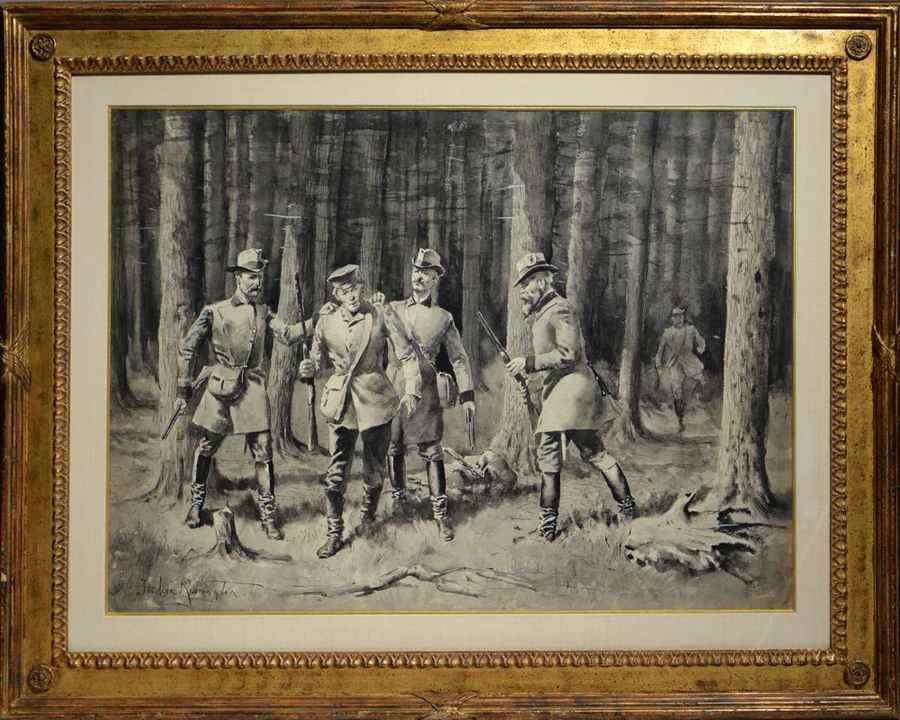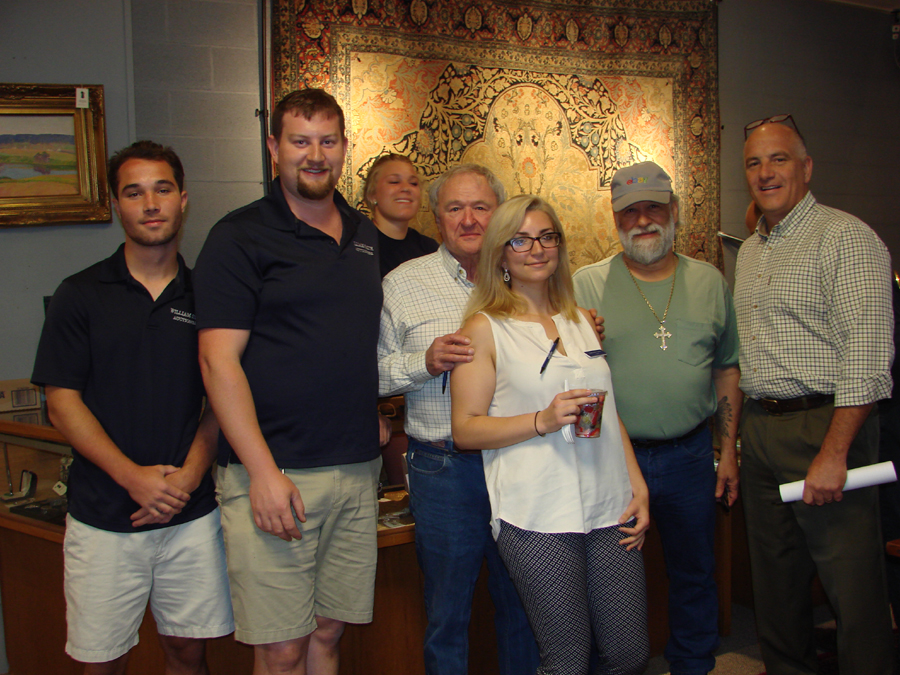Review and Onsite Photos by Rick Russack;
Additional Photos Courtesy William A. Smith
PLAINFIELD, N.H. — A full house turned out for Bill Smith’s Memorial Day weekend sale. Day one was set aside for coins and silver, and he had advertised that portion of the sale as including a “ton of silver.” Prices were solid throughout, but the second day of the sale produced the highest prices of the weekend. A still life painting by R.S. Dunning sold for $109,250, and a gouache by Frederic Remington brought $30,498. Country furniture in old paint, mostly from one collection, did well, as did estate jewelry. A large E. Howard clock with a marble dial and gilt case caught the eye of many.
Robert Spear Dunning (American, 1829–1905) was best known for his still life paintings, and past examples have sold in the $250,000 range. The painting Smith offered was a large, colorful composition with a watermelon, grapes and several other fruits. Dunning’s work was well received in its day and he became a member of the National Academy where his paintings were exhibited between 1850 and 1880.
In 1870, Dunning, with a friend, established the Fall River Evening Drawing School. His students learned about still life painting, and several of his students went on to success in that field. The painting offered by Smith had a strong connection to Fall River, having descended in the family of one of the attorneys who had defended Fall River’s Lizzie Borden when she was charged with the 1882 axe murders of her parents. She was acquitted of the charges, but the case was, and still is, heavily debated and has been the subject of numerous books, television programs and movies.

The highlight of the weekend sale was a colorful still life painting signed “R.S. Dunning, 1867,” which sold to a phone bidder for $109,250. Dunning taught still life painting in Fall River, Mass., and this painting descended in the family of a Fall River attorney who had been involved with defending Lizzie Borden.
“Arrest of the Poacher in the Woods,” a 29-by-21-inch gouache by Frederic Remington (American, 1861–1909) brought $28,750. As Smith was selling it, he said that it had once sold for $56,000. According to the catalog, it had been published in Harper’s Monthly in April 1894. An exceptional watercolor by Ogden Pleissner, (American, 1905–1983), titled “The Evening Fishing” realized $40,250. Pleissner worked mainly in oils until serving in World War II as a war artist, stationed in the Aleutian Islands. The damp climate required that he work in watercolors because they dried faster than oils.
Smith also offered one of Frank Shapleigh’s classic scenes looking out of a barn towards the White Mountains. It was titled “Moat Mountain From Old Barn in Jackson, New Hampshire,” and the final price was $8,625. A two-masted steamship on a choppy ocean with an American flag and pennants flying by Antonio Jacobsen (American, 1850–1921) reached $9,775. It was signed “Antonio Jacobsen, New York 1877, 257 8th Avenue near 23st.” The sale included three paintings by Henry MacGinnis (American, 1875–1962), and all sold to the same phone bidder. Bringing the highest price of the group, $2,300, was a farm scene painted in nearby Orford, N.H. A harbor scene by the artist fetched $1,610.
Country furniture in old paint did noticeably better than it has in some other recent auctions. Most of the pieces came from a single collection. An exceptional cupboard in wonderful blue paint brought $4,312. The top section had two glass doors, each with nine panes of old glass, and the lower section had four drawers over two doors. A two-part cupboard in old red with raised panel doors top and bottom achieved $1,495, and a green corner cupboard with an arched top went out for the same price. An unpainted, set-back open cupboard with plank doors and a deep patina also brought $1,495.
Formal furniture included a Federal tall case clock with an inlaid mahogany case and a dial signed by Joakim Hill, Flemington, N.J., a well-respected and -known clock maker. It realized $13,800. A New Hampshire tall case clock by L.&A. Hutchins of Concord with an inlaid case achieved $7,475. A circa 1820 two-part secretary with bookcase top from the workshop of Porter Blanchard finished at $5,175. It had an old surface with flame birch and bird’s-eye maple paneled doors. Blanchard worked in Salisbury, N.H., home of the Dunlap family of cabinetmakers, and in 1809 Blanchard bought the cabinetmaking shop of Levi Bartlett. Not all the Federal furniture brought substantial prices. Definitely a good buy was a circa 1810 North Shore mahogany card table on reeded legs and with inlaid flame birch panels. It only made $920.

The salesroom was packed. Smith does not use internet bidding, which seems to translate into good attendance at the sale.
Some other pieces of furniture are worth mentioning. A one-drawer Mission oak bookcase, signed Roycroft and with an old finish, brought $8,625. As he was selling it, Smith said, “This may look familiar to some of you. We sold it last time for $11,000 but the buyer never paid for it. So here it is.” Another Mission bookcase, this one by L.&J.G. Stickley, went for $3,738. One of the best of early workbenches, this one with a thick maple top, three drawers, two vises and more, sold for $2,875. Certainly a bargain was an English Regency sewing stand, with drop leaves and brass inlay in an exotic wood that Smith could not identify. It went for only $460.
Smith’s sales often include estate jewelry and this one was no exception. A ring with a round brilliant cut, GIA-certified 1.91-carat diamond realized $13,800 from a dealer in the room. He also paid $11,500 for a 3.01-carat diamond ring set in platinum with approximately .60-carat total weight of side diamonds. The buyer told Antiques and The Arts Weekly, “Smith gets good jewelry and I’m always able to make money with it. I think the $11,500 ring was really a good buy.” A 1926 Saint-Gaudens $20 gold coin, set as a pin in a bezel with 19 blue sapphires, fetched $2,645.

Frederic Remington’s gouache “Arrest of the Poacher in The Woods” brought $28,750. It was published in an 1894 issue of Harper’s Monthly.
Coins and silver were sold on the first day of the weekend. Topping the coin selection was a Bechtler $1 gold coin, which achieved $5,520. Bechtler, who worked in North Carolina, ran a private mint producing gold dollars in the 1830s and 1840s before the federal government did so. His coins were widely trusted and he became wealthy producing them. One of the two most popular silver lots was a six-piece sterling tea set by Black, Starr and Frost-Gorham, weighing 191 troy ounces, which made $4,140. The other was an assembled set of 200 pieces of Kings pattern sterling flatware weighing 253 ounces, which also fetched $4,140. A two-piece Gorham sterling presentation covered potpourri urn with under tray earned $2,760.
The second day of the weekend sale offered a Paul Evans glass top dining table on a steel base, which sold for $5,750. Bringing a final price of $19,550 was a Steinway Model S baby grand piano, while another baby grand went for $3,749. Requiring an explanation from the podium was a Nineteenth Century, 92-inch delicately spiraled narwhal tusk, which realized $8,913. Complex federal and international laws restrict trafficking of these tusks. Smith said that New Hampshire has no restrictions, but marine dealers in the room said that interstate shipping is barred and that dealing in this type of artifact requires knowledge of applicable regulations. Smith said that certification of the age of this tusk could be obtained by companies that provide such a service. While this certification is available, it is not inexpensive. One bidder said that had he been successful, he would have kept the item in his own collection.
All prices reported include the buyers’ premium. For information, 603-675-2549 or www.wsmithauction.com.






